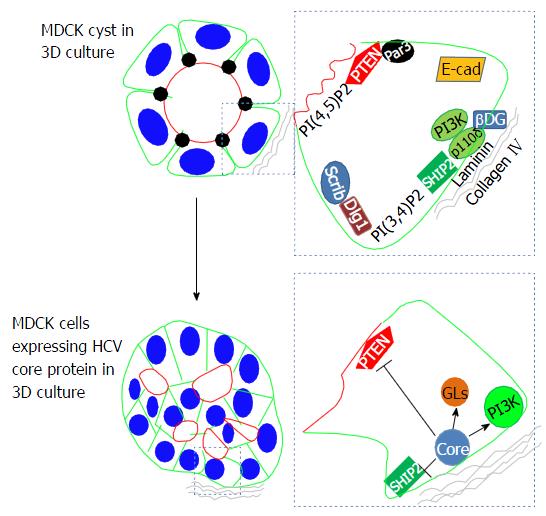Copyright
©The Author(s) 2017.
Figure 4 Effects of hepatitis C virus infection on cell polarity.
In a 3D culture, MDCK form a cyst comprising a monolayer of cells around a lumen (the basolateral membrane is indicated in green, the apical membrane in red and the tight junctions in black). The right-hand column shows a zoom of a polarized cell. PI3K is activated by E-cadherin. The p110δ subunit is activated by ECM (Laminin and collagen IV). SHIP2 and PI(3,4)P2 at the basal membrane are responsible for the Dlg1/Scribble complex at the basolateral membrane. PTEN interacts with Par3 at the tight junctions and its lipid product PtdIns(4,5)P2 is localized at the apical membrane. The bottom column represents the multi-lumen phenotype of cysts expressing HCV core protein. The presence of this core protein at the basolateral membrane activates PI3K and inhibits SHIP2 and PTEN, leading to a loss of cell polarity and an accumulation of lipid droplets (LDs). HCV: Hepatitis C virus; PtdIns: Phosphatidylinositol; PI3K: Phosphoinositide 3-kinase; SHIP2: SH2-containing inositol polyphosphate 5-phosphatase; PTEN: Phosphatase and tensin homologue deleted on chromosome 10; MDCK: Madin darby canine kidney; DG: Dystroglycan.
- Citation: Awad A, Gassama-Diagne A. PI3K/SHIP2/PTEN pathway in cell polarity and hepatitis C virus pathogenesis. World J Hepatol 2017; 9(1): 18-29
- URL: https://www.wjgnet.com/1948-5182/full/v9/i1/18.htm
- DOI: https://dx.doi.org/10.4254/wjh.v9.i1.18









